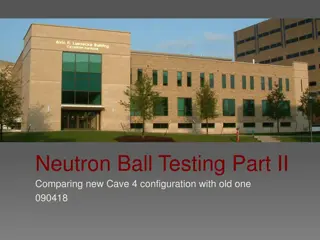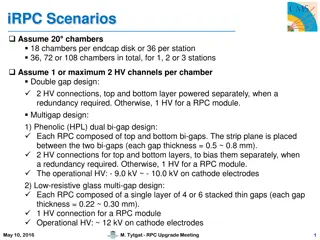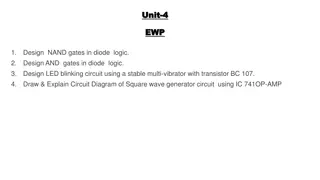Atomic Configurations and Term Symbols
The energy of atomic configurations is determined by electrostatic attraction between electrons and the nucleus, electron-electron repulsion, spin-orbit coupling, and spin-spin interactions. Term symbols in electronic spectroscopy specify atomic states using quantum numbers. Hund's rule and the Paul
8 views • 12 slides
Logic Families
Logic families such as Diode Logic (DL), Resistor-Transistor Logic (RTL), and Diode-Transistor Logic (DTL) each have distinct capabilities and limitations when it comes to performing logic functions. While DL gates are simple and inexpensive but limited in functionality, RTL gates offer both normal
1 views • 22 slides
Transistor Biasing Circuits: A Comprehensive Overview
Biasing is crucial for the proper functioning of transistor circuits, ensuring they operate in the active region as amplifiers. This process involves setting DC voltages to establish the correct operating conditions for the transistor. By providing the necessary biasing, amplification of small input
0 views • 41 slides
Introduction to Uni-Junction Transistor (UJT) in Electronic Semiconductors
Uni-Junction Transistor (UJT) is a semiconductor switching device with unique characteristics, such as regenerative emitter current increase when triggered, leading to a negative resistance region. It finds applications in sawtooth and pulse generation, switching, and triggering SCRs & TRIACs. The U
0 views • 15 slides
The Two-Transistor Model of SCR for Beginners
Explore the two-transistor analogy of SCR, a method illustrating SCR as a combination of PNP and NPN transistors. Discover how the working principle is easily explained through this model, showcasing the transition from off to on state when triggering the SCR. Uncover the accumulative action of curr
1 views • 8 slides
PSD-based Energy Detect Threshold (EDT) in ETSI 5 GHz Standard
ETSI BRAN adopted a PSD-based EDT into the 5 GHz standard, specifying thresholds for energy detection levels. The new definition replaces the previous -72 dBm/20 MHz EDT, offering a compromise between power limits and channel configurations. Detailed examples and operational guidelines are provided
0 views • 6 slides
Transistor Operation through Collector Characteristic Curves
Collector characteristic curves provide insight into the transistor's operation in various regions such as cutoff, saturation, and active. By analyzing the relationship between collector current (IC) and collector-to-emitter voltage (VCE) with base current variations, one can understand how a transi
0 views • 7 slides
Bipolar Transistor Configurations for Electronic Circuits
Explore the three common configurations - Common Base, Common Emitter, and Common Collector - for Bipolar Transistors in electronic circuits. Each configuration offers unique characteristics such as voltage gain, current gain, and impedance levels, impacting the signal processing and amplification c
0 views • 27 slides
Discussion on Multi-PUSCH Configuration for UTO-UCI Content Moderator at Ericsson
This discussion encompasses the configuration and implications of the Multi-PUSCH setup based on agreed parameters within the UTO-UCI content moderation context at Ericsson. It delves into varying configurations, potential impacts, and considerations for effective utilization. The slides provide ins
0 views • 17 slides
Transistor-Transistor Logic (TTL) Circuits
Transistor-Transistor Logic (TTL) is a popular digital circuit technology known for its speed and reliability. This technology utilizes totem pole output stages for efficient performance. TTL logic gates have varying characteristics like power dissipation and speed, making them suitable for differen
0 views • 5 slides
Electronic Meeting Agenda: UE PC2 for NR Inter-Band CA and SUL Configurations
The document relates to the upcoming electronic meeting of 3GPP TSG-RAN WG4, focusing on UE power class 2 for NR inter-band Carrier Aggregation and supplemental uplink configurations. It includes background contributions, identified issues, and options for SAR schemes addressing duty cycle based sol
5 views • 5 slides
Evolution of Semiconductor Devices in Modern Electronics
The lecture discusses the fundamentals of semiconductor drift and diffusion currents, diode behavior, transistor characteristics, and amplifier circuits in ECE 255. It explores the origins of modern electronics, from the invention of the bipolar transistor to the evolution of electronic devices thro
0 views • 35 slides
RC Coupled Amplifiers and Transistor Basics
Amplification is the process of increasing signal strength without changing its characteristics. An RC coupled amplifier is a multistage amplifier using resistors and capacitors. Transistor amplifiers amplify signals based on transistors with different configurations. The common emitter configuratio
0 views • 23 slides
Transistor Tuned Amplifiers: Operation and Analysis
Transistor tuned amplifiers consist of a parallel tuned circuit as the collector load, amplifying a specific frequency while rejecting others. The resonant frequency of the tuned circuit is crucial for amplification. A high Q circuit offers maximum voltage gain at the resonant frequency but decrease
0 views • 30 slides
Configurations and Tests Overview in Integrated Applications
This content provides an overview of various configurations and tests in integrated applications, covering aspects such as status, loaded configurations, readiness checks, server tests for HV and LV systems, as well as client-server interactions. It details the different components involved and thei
0 views • 5 slides
Transistor Bias Circuits for Linear Amplification
Transistor bias circuits play a crucial role in setting the DC operating point for proper linear amplification. A well-biased transistor ensures the signal variations at the input are accurately reproduced at the output without distortion. Various biasing methods such as Voltage-Divider Bias, Emitte
0 views • 7 slides
Networking Setup Overview for FAS2620 and FAS2240 Systems
This content provides detailed information about the networking setup for FAS2620 and FAS2240 systems, including connections, ports, and cabling configurations. It includes images and descriptions of the setup for cluster configurations, disk shelves, and switch connections.
0 views • 5 slides
PDSCH Demodulation Parameters & Requirements Discussion
This document covers the discussion on PDSCH demodulation parameters and requirements for UE demodulation and CSI reporting in FR2 DL 256QAM, specifically focusing on static channel mode, TDL-D channel mode, and TDL-A channel mode. The document also explores rank options, channel bandwidth, PRB allo
0 views • 9 slides
Microelectronic System Design by P. Bruschi - Overview of Cascode Current Mirrors and Wide Swing Configurations
Explore the detailed design of microelectronic systems by P. Bruschi, focusing on cascode current mirrors and wide swing configurations. The content includes various images illustrating classic and non-optimal topologies, parameters, and voltage shifters for MOSFET mirrors. Learn about high precisio
0 views • 14 slides
IEEE 802.11-24/0858r0: Key Concepts on NPCA and Virtual APs
This document discusses key concepts related to NPCA (Neighbor-Primary Channel Announcement) and Virtual Access Points (APs) in the context of IEEE 802.11 standards. It covers topics such as multiple BSSID sets, co-hosted APs, NPCA primary channel configurations, and criteria for channel switching.
0 views • 9 slides
Hardware Configurations for Project Cysera by Zoebir Bong
This document outlines proposed hardware configurations for Project Cysera drafted by Zoebir Bong. It includes options from Dell and Lenovo servers with both remote and local data storage solutions. Each configuration specifies server models, network switches, processors, memory, storage drives, net
0 views • 8 slides
Windchill Performance Tuning Webinar Insights
Explore common themes of Windchill performance issues and learn preventive measures to enhance system stability and user experience. Delve into database-related causes, system misconfigurations, and client-side configurations. Discover essential tips for optimizing database performance and server/cl
0 views • 12 slides
Comparison of New and Old Cave Configurations in Neutron Ball Testing
This content discusses the comparison between the new and old cave configurations in the Neutron Ball testing part II. It showcases images and descriptions of the different cave configurations, highlighting the progress in research at the Cyclotron Institute. The Neutron Ball's functionality and tes
0 views • 14 slides
Designing Elastomeric Vibration Isolators: Key Parameters and Configurations
Exploring the design aspects of elastomeric vibration isolators, including material selection, key design parameters, simple isolator configurations, spring rates, transmissibility, and shape factor calculations. Learn how engineered properties of elastomers can meet specific application requirement
0 views • 26 slides
Fundamentals of Computer Networks
Explore the essentials of computer networks, covering topics such as DHCP, NAT, IPv6, server operations, and IP address allocation. Understand how DHCP servers control IP address pools and provide network configurations to clients. Learn about address leases for dynamic allocation and how DHCP clien
0 views • 35 slides
Emerging Materials for MOS-Transistor Gate Stacks in Semiconductor Technology
Advancements in semiconductor technology necessitate the adoption of new materials for gate stacks in MOS-transistors, addressing issues like gate leakage current and gate oxide problems. With the continual scaling down of MOSFETs, the use of high-K materials offers solutions to enhance performance
0 views • 51 slides
Procedures and Configurations of Test Cases on Cell Switch Delay
The procedures and configurations for testing cell switch delay in LTM involve introducing test cases T1 to T5, each with specific actions related to UE timing information, LTM configuration, TCI activation, RACH triggering, and cell switch verification. Different UE capabilities dictate the testing
0 views • 7 slides
Thermal Analysis of a Bipolar Transistor Using COMSOL
This model utilizes a COMSOL simulation to analyze the thermal behavior of a bipolar transistor. The heat transfer within the device is calculated to determine the temperature distribution. Various plots, such as the Gummel plot and current gain curve, illustrate the collector and base currents as f
1 views • 11 slides
Comprehensive Review of BJT CE Voltage Amplifier in Electronics Lab
This lecture provides a comprehensive review of the BJT CE voltage amplifier circuit, starting with theoretical concepts and moving towards practical implementations. It covers the operation of the BJT as a switch, the addition of resistors for current control, DC design considerations, AC voltage g
0 views • 19 slides
School District Facility Study and Elementary School Options
Crabtree, Rohrbaugh & Associates conducted a district-wide facility study for a school district, proposing various options for elementary school configurations. Options range from maintaining existing buildings to creating new centralized schools, each with different grade configurations and renovat
0 views • 51 slides
Electron Configurations and the Periodic Table in Chemistry
Explore the world of electron configurations in atoms, subshells, and electron arrangement using the periodic table. Learn about the organization of electrons in subshells, different ways to represent electron arrangements, and how to determine electron configurations based on the periodic table. Di
0 views • 12 slides
High Voltage and Front-end Electronics for iRPC Upgrade
Detailed information regarding the high voltage configurations and front-end electronics setups for the upgraded Resistive Plate Chambers (RPCs). It covers different RPC designs, operational voltages, chamber configurations, HV connections, and power consumption data for the front-end electronics. T
0 views • 6 slides
Nonstationary Configurations of a Spherically Symmetric Scalar Field
Action and stress-energy tensor, Einstein-Klein-Gordon equations, and method for constructing nonstationary configurations of a spherically symmetric scalar field are discussed in this study. The behavior of the characteristic function allows interpretations such as black holes, wormholes, or naked
0 views • 14 slides
Overview of Magnet Configurations at GSI Helmholtzzentrum GmbH
This document provides detailed information on the magnet configurations at GSI Helmholtzzentrum GmbH, focusing on multiplet designs, magnetic field simulations, quadrupoles, sextupoles, and steering dipoles. It covers the general design of SC multiplets, requirements on axis and angles, and specifi
2 views • 17 slides
Electronic Configurations Through Simplified Assignments
Exploring electron configurations and orbital regions using simplified notations colored in on Periodic Charts. Descriptions and visual aids for Carbon, Fluorine, and excited state of Fluorine. Learn to assign s, p, d, and f electron neighborhoods without memorization through a fun song. Includes te
0 views • 14 slides
Diode and Transistor Logic Circuits for LED Blinking and Logic Operations
Dive into the world of diode and transistor logic circuits with designs for NAND and AND gates, as well as LED blinking circuits using stable multi-vibrators. Learn how these circuits function and discover the components involved in creating a square wave generator. Explore the practical application
0 views • 9 slides
MOIMS Protocol Viewpoint for SEA Reference Architecture Updates
This content describes the MOIMS Protocol Viewpoint inputs to the SEA Reference Architecture updates by Roger Thompson from ESA SAWG. It includes details about the graphical conventions, data store elements, organizational domains, network layers, communications protocols, and space communications c
0 views • 21 slides
Proposed Campaign Experiment in FY24 for OMEGA EP
This proposal outlines the experiment details for the FY24 OMEGA EP campaign, including the purpose, specific deliverables, comparison with PI/Designer, technical issues, budget estimates, and experimental configurations required. It covers the VISRAD model configuration, experimental setup, shots o
0 views • 4 slides
DC Motor Control Techniques and Configurations
This chapter delves into various aspects of PWM and DC motor control, exploring characteristics of selected DC motors, rotation mechanisms, H-bridge configurations for motor direction control, logic configurations for motor operation, bidirectional motor control using an L298 chip, pulse width modul
0 views • 27 slides
VLSI Design Methodologies and Layout Rules: A Comprehensive Overview
This detailed content provides an in-depth exploration of VLSI design methodologies and layout rules, focusing on topics such as standard cell layout methodology, transistor dimensions, design rules for n-well process, and more. The information covers important aspects like minimum widths, spacings,
0 views • 35 slides




































